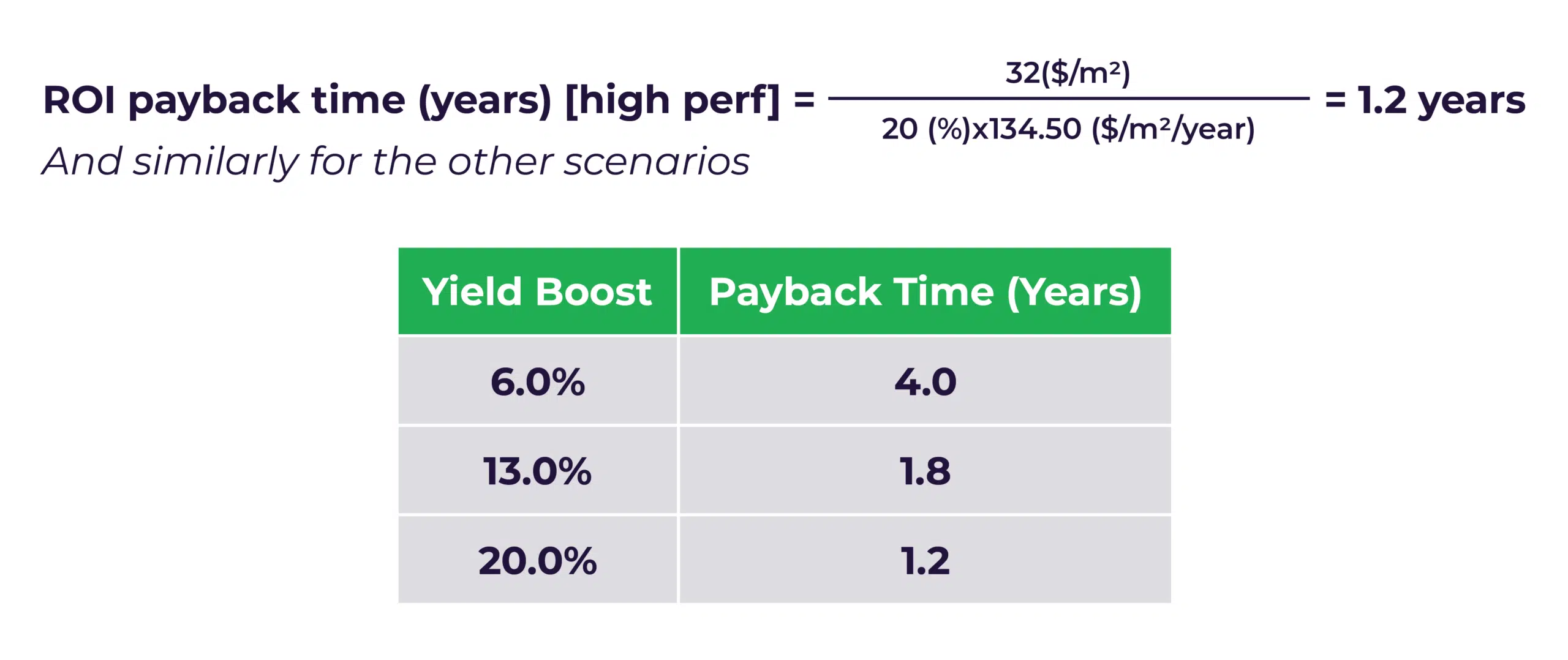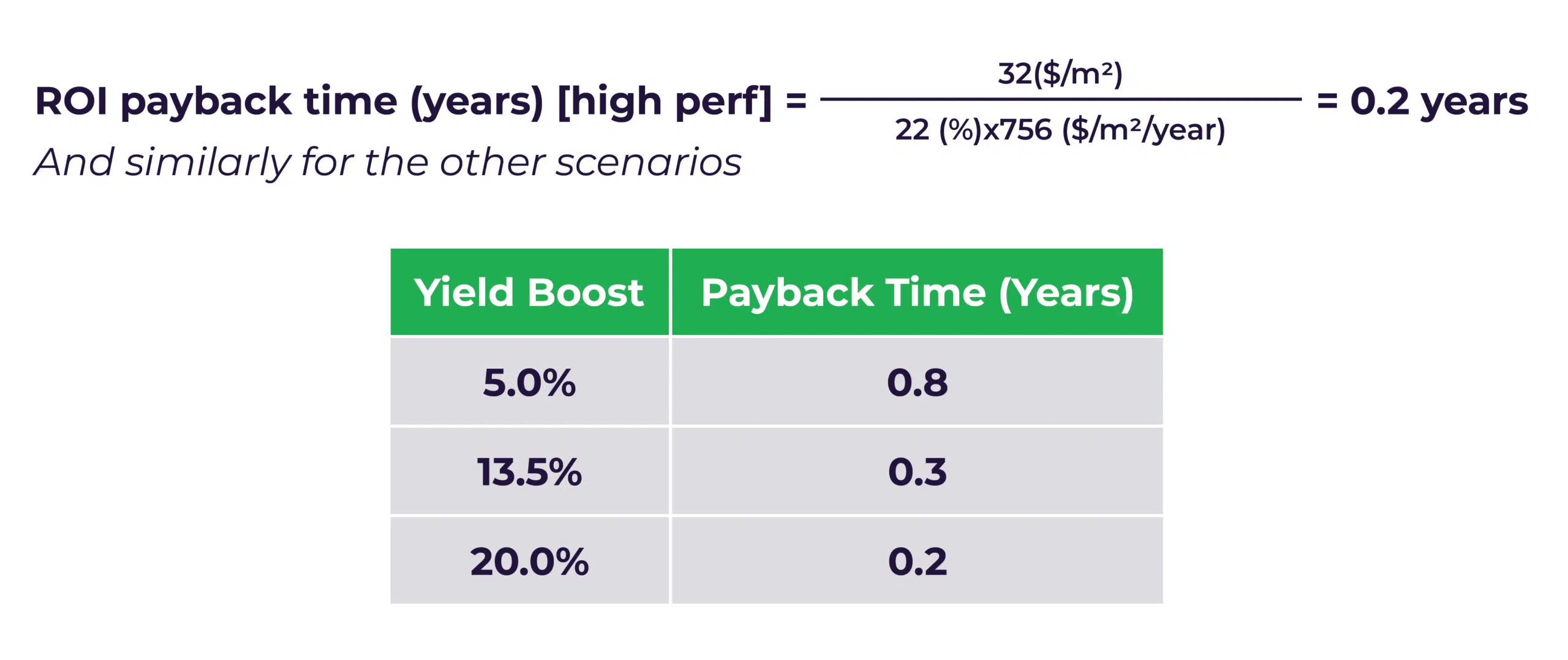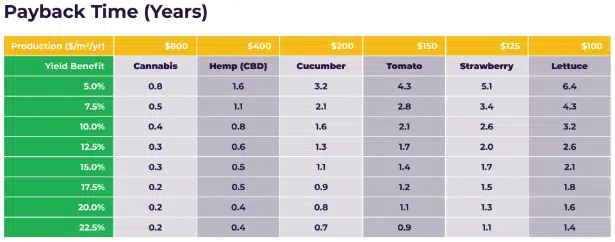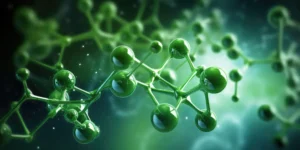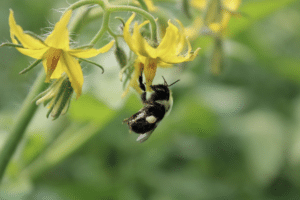
Calculating The Return On Investment Payback Time For Yield-Enhancing Technologies
Highlights:
- Calculate your greenhouse’s productivity.
- Estimate your crop’s yield enhancement.
- Compare the payback time to technology lifetime.
- Examples for tomatoes and cannabis.

This article will walk you through a simple but essential calculation of the return on investment (ROI) for greenhouse investments, specifically focusing on the greenhouse ROI payback time for UbiGro. Moreover, the calculation applies to any crop yield enhancement technology used in greenhouse production to improve crop yield.
Greenhouse Productivity
The goal here is to calculate your greenhouse’s productivity and ROI (Return on Investment), in units of dollars per area per year, for a given crop. This gives us a baseline productivity upon which a greenhouse yield improvement is added. To improve crop yield and thus increase greenhouse production, just take the total revenue for an average year, and divide by the greenhouse footprint area. This method is essential in understanding how to enhance greenhouse production efficiency and ROI through strategic yield improvements.
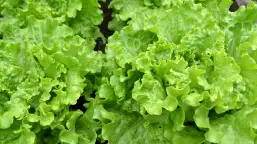
Example (1)
Bob’s greenhouse grows beefsteak tomatoes in New Mexico. Bob has 1487 m2 (16,000 ft2) of greenhouse footprint across several greenhouses. Looking at his historical production, Bob knows that, on average, over the past five years, these greenhouses produce about 100,000 lbs of tomatoes per year, and his average wholesale price is $2/lb, so his average yearly revenue is $200,000/year. Per unit area, this productivity is $134.50/m2/year ($12.50/ft2/year).
Example (2)
Kim’s greenhouse grows recreational cannabis in California. Kim has several greenhouses, each 201 m2 (2,160 ft2) in footprint. Looking at her historical light deprivation and full season production, Kim knows that on average over the past five years, each greenhouse produces about 186 lbs of dry/trimmed cannabis per year and 47 lbs of trim per year, when combining the two seasonal harvests. With her average wholesale price of $800/lb for dry/trimmed cannabis and $100/lb for trim, her average yearly revenue is $153,500/year from each greenhouse. Per unit area, this productivity is $765/m2/year ($71/ft2/year).
Yield Benefit
Here’s where we have to estimate the performance of the yield enhancement technology in greenhouse production. We can leave the performance as a variable in order to assess the payback time for different results in terms of greenhouse ROI. UbiGro has shown yield enhancement performance at various sites from +5% to +28%, contributing to improved crop yield in greenhouses. The actual performance at a given greenhouse can’t be known before a trial, so for ROI calculation in greenhouse production, we can look at a range of outcomes to understand how to improve crop yield effectively.
Example (1)
Bob has learned that for tomatoes, UbiGro has shown yield enhancements from +6% to +20%. He has decided to look at low- (6%), mid- (13%) and high-performance (20%) outcomes to make his ROI decision.
Example (2)
Kim has learned that for cannabis, UbiGro has shown yield enhancements from +5% to +22%. She has decided to look at low- (5%), mid- (13.5%) and high-performance (22%) outcomes to make her ROI decision.
Installation Cost
The last piece of the puzzle is to determine the installation and maintenance cost of the yield-enhancing technology on a per-area basis. UbiGro’s bulk installation cost is $32/m2 ($3/ft2) for large area installations, with zero maintenance cost. If there were a maintenance cost ($/area/year) for a given technology, the proper calculation would be to subtract this cost from the farm revenue.
Example (1)
Now Bob can put together all of this data and come up with a payback time for the three performance scenarios. For high-performance:
Example (2)
Kim can come up with a payback time for the three performance scenarios. For high-performance:
Compare The Payback Time To Technology Lifetime
The final decision point in greenhouse ROI comes when comparing the expected payback time to the actual lifetime of the technology in greenhouse production. For UbiGro, aimed at improving crop yield, the lifetime is 4-6 years in the greenhouse.
Example (1)
Bob can see that he has a range of expected outcomes. The best case scenario (+20%) is a very fast 1.2 year payback time on UbiGro that lasts over four years in the greenhouse, realizing Bob excess profitability for at least 2.8 years of the film’s lifetime. If Bob’s tomatoes experience the lowest expected yield enhancement, then the UbiGro film would still pay for itself in 4 years.
Example (2)
Kim’s range of expected outcomes are all exceptional given the high value of the cannabis crop. The best case scenario (+22%) is a very fast 0.2 year payback time, essentially one harvest, on UbiGro that lasts over four years in the greenhouse, realizing Kim excess profitability for the vast majority of the film’s lifetime. If Kim’s cannabis harvests experience the lowest expected yield enhancement, then the UbiGro film would still pay for itself in less than one year.
Putting It All Together
Based on UbiGro pricing and market research we’ve conducted with various greenhouses, focusing on greenhouse production, we can use this model to predict payback times for various yield benefit outcomes, and inform the grower’s decision on greenhouse investment, focusing on enhancing crop yield and maximizing ROI in the greenhouse setting. The table below summarizes these findings related to greenhouse investment, greenhouse production, crop yield enhancement, and the strategic financial benefits associated with improved greenhouse ROI, aiming at how to improve crop yield and greenhouse ROI.

Dr. Damon Hebert
Dr. Damon Hebert serves as Director of Agriculture Research for UbiQD, Inc., with a background in solar materials and controlled environment cannabis cultivation. He is an advocate for the use of advanced materials to further the industry’s push towards sustainable farming practices. He can be reached at [email protected].

Dr. Damon Hebert
Dr. Damon Hebert serves as Director of Agriculture Research for UbiQD, Inc., with a background in solar materials and controlled environment cannabis cultivation. He is an advocate for the use of advanced materials to further the industry’s push towards sustainable farming practices. He can be reached at [email protected].
Share:
Connect With Us
Company
Resources


Hunter McDaniel, PhD
Founder & CEO
Hunter earned a Ph.D. in Materials Science and Engineering at the University of Illinois at Urbana-Champaign, before joining Los Alamos National Laboratory in the Chemistry Division. Ultimately the value proposition of UbiGro is about boosting crop yields and quality without the cost or energy impact of lighting. Hunter has more than fifty publications and patents, and more than 2000 total citations, h-index: 20. Hunter fundamentally believes that novel materials underpin every significant technology advancement, and he is focused on leveraging new materials to have a lasting and sustainable impact.

Damon Hebert, PhD
Director of Agriculture
Damon brings a wide range of experience in agriculture, materials science, spectroscopy, and small business. During his time in Prof. Angus Rockett’s research group at The University of Illinois at Urbana-Champaign (UIUC), Hebert authored a doctoral thesis and multiple papers on the materials science of CIGS semiconductor materials, which is closely related to the materials developed at UbiQD. He also served as a consultant to Nanosolar, a CIGS nanocrystal solar cell manufacturing company. Hebert has industry experience having co-founded Dr. Jolly’s, a leading cultivation and distribution operation in Bend, OR.

Tania Lafaille
Sales Representative
Tania is a UbiGro Sales Representative, with over 7 years of experience in product sales (specifically berries and avocados) covering all of North America and parts of South America. While in agriculture, Tania has cultivated strong relationships with growers and distributors, granting her a unique insight into both perspectives. That understanding, paired with her fierce dedication to results, drives her fun and fiery commitment to her craft. Tania is based in Gilroy, CA.
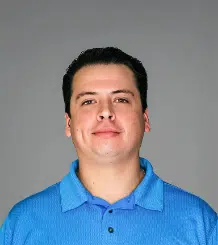
Tyler Veyna
Sales Representative
Tyler brings 15 years of experience in Greenhouse production and facility management of a wide range of crops in multiple states to the UbiGro team. Based in Salinas, California. “Being a fourth-generation farmer, I look to improve and empower the grower, and with UbiGro, we can do just that.”

Jim Gideon
Sales Manager
Jim Gideon is an UbiGro Sales Manager, with over 25 years of greenhouse industry sales experience covering all of North America. Previously Jim has worked for Green Tek, Plazit-Polygal, Texel, Cherry Creek, and Nexus. He is based in Montgomery, AL, and Jim believes that “light is everything to the grower.”

Eric Moody
Director of Sales
Eric Moody is UbiQD’s Director of UbiGro Sales. Eric has more than 6 years of experience in horticulture lighting industry, building relationships with greenhouse growers of all sizes and crops on optimal lighting for their growing operation, and most recently managed a North American sales team for PL Light Systems. Overall, Eric has been in sales leadership positions for more than 13 years. Eric brings with him a great understanding of the market and available technologies for growers, greenhouse facilities, and sales leadership. Reach Eric by phone at 541-490-6421 or by email at [email protected].

Mike Burrows, PhD
Dr. Michael Burrows is UbiQd’s Vice President of Business Development. His educational background includes a Materials Science doctorate from the University of Delaware and an MBA from Duke University Fuqua School of Business. His career has specialized in the commercialization of novel electronic materials in venture-run programs for different industries including solar, biosensors, and the automotive industry. In both start-up and corporate environments, he has extensive experience in global market development, foraging supply chain partnerships, productization, and brand building. He is currently leading UbiQD’s partnership efforts in luminescent greenhouse technology, smart windows, and security ventures.

Matt Bergern, PhD
Cheif Product Officer
As Chief Product Officer at UbiQD, Dr. Matt Bergren leads the company’s product development efforts, sales, and product manufacturing, including the company’s first commercial agriculture product, UbiGro. He plays a critical role in continuing the company’s path of technology development and vision of powering product innovations in agriculture, clean energy, and security.
He serves as the principal investigator for UbiQD’s contract with NASA, focused on tailoring the solar spectrum for enhanced crop production for space missions. Dr. Bergren’s leadership experience includes serving on the board of directors for the New Mexico Energy Manufacturing Institute, focused on job creation in New Mexico’s energy, and related manufacturing community.


